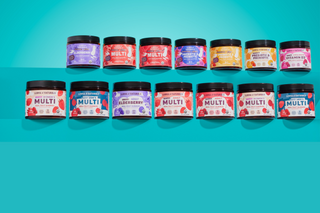Key Points:
- Children need a wide range of nutrients to make sure their bodies can develop and function well.
- They need large amounts of the macronutrients — protein, carbohydrates, and healthy fats.
- They also need smaller amounts of the micronutrients, which include vitamins and minerals.
- Help them to get these important nutrients for kids by serving them a variety of healthy foods daily.
- If you’re worried they may not be getting enough of the essential nutrients, you might consider supplements to fill the gap.

The phrase “healthy eating” is often bandied around but many parents don’t know what that looks like in practice. In essence, healthy eating means making sure your child gets enough of all the critical nutrients for kids. Those nutrients help their little bodies develop properly and set them up for a lifetime of health.
Let’s explore the critical nutrients your little one needs as they’re growing up and why they’re so important. We’ll also provide some healthy meal suggestions to maximize those all-important nutrients for kids.
Why Is Healthy Eating So Important?
Although many (but not all) children in the U.S. do have enough to eat, much of the food they’re consuming isn’t necessarily healthy. In fact, there are many common “foods” that don’t really qualify as food at all, as they contain very few nutrients for kids.
On the other hand, they do contain plenty of added sugar and other unhealthy ingredients, like artificial sweeteners, colors, and flavors, trans-fats, and preservatives — which can actively damage your child’s health. The epidemic of obesity, allergies, and intolerance is testimony to this sad state of affairs.
Understanding the essential nutrients your child needs — and which healthy foods are good sources of these — is the first step towards improving and maintaining your child’s health.
So What Does Healthy Eating Look Like?

As humans, there are two broad categories of nutrients that we need for a healthy diet: macronutrients and micronutrients.
The macronutrients are protein, carbohydrates, and fats. A balanced diet includes all of these, and your child’s body needs them in relatively large quantities on a regular basis.
The micronutrients are chemical substances like vitamins and minerals. The human body can make some of them but the ones it can’t make — which are called “essential micronutrients” — need to come from food. Although children need only small quantities of these, each one is important as it supports your child’s growth and development.
Both adults and children need these important nutrients, but because children’s bodies are so much smaller, they need less. Luckily there are resources available that list exactly how much children need based on gender and age.
Bear in mind that these guidelines may vary if your child has a health condition of any kind. If that’s the case, consult a doctor for medical advice on any food limitations you should consider.
Let’s look at nutrients for kids in a bit more detail, starting with the macronutrients.
Macronutrients
As we’ve mentioned, the macronutrients are protein, carbs, and fat. Together, these are sources of energy and keep the body functioning well.
Protein
Protein is so critical because it provides the body with essential amino acids — which the human body can’t make. Your child’s body recombines the amino acids they get from food to create the new proteins responsible for building all the main structures of the body, including the cells, bones, muscles, and organs. Protein is also involved in keeping the systems of the body functioning, and it boosts the immune system and helps keep your little one fueled with energy.
While red meat, chicken, and fish are all touted as good sources of protein, they come with other issues around health and sustainability. If you’re going to give your child animal protein, aim for lean meat, preferably hormone-free.
However, the best protein sources for kids are legumes, like beans, chickpeas, and lentils, soy products like tofu and tempeh, nuts and seeds, and whole grains. Combining plant protein, like beans, with whole grains, like brown rice, is preferred, as that gives your child the full range of essential amino acids. There are also some veggies that provide some protein, like leafy greens, spinach, broccoli, and sweet potatoes.
Carbohydrates
The carbohydrates your child eats provide their body with the energy they need to run around and swing from jungle gyms. Carbs also support the brain and central nervous system, as well as other functions like building and repairing body tissues.
Carbs are often available in the form of sugar, starch, and/or fiber. The challenge here is that there are “good” carbs and “bad” ones.
The less healthy ones — like French fries, refined white bread, cookies, and sodas — are usually highly processed, stripped of nutrients for kids, and often contain lots of the less-desirable ingredients we mentioned earlier, like sugar and preservatives. They give your child a quick boost of unsustainable energy — which can translate to a sugar high — and contribute to weight issues, as well as heart disease and diabetes.
The healthiest carbohydrates are processed as little as possible, so they still contain vitamins, minerals, and fiber — which helps your little one’s body digest food and then move any waste products through their system.
Whole-grain cereals like brown rice, oats, and quinoa, or even whole-wheat bread, are great sources of healthy carbs, as are legumes and fresh fruit and vegetables.
Healthy Fats
Despite the bad rap that fats have received over the years, your little one does need a certain amount of healthy fat — the key word here being “healthy.” Healthy fats are involved in many cell and hormonal processes, and they also store and provide energy.
Once again, we have some fats that are better for us than others. The “bad” fats usually come from highly processed foods and contain almost no nutrients for kids. Unhealthy fats often show up in the form of trans-fats, which contribute to many diseases. Because of this, it’s important to limit foods that contain these kinds of fats, like cookies, cake, fries, and ice cream.
Also, be wary of supposedly healthy low-fat foods. To replace the fat and still make the products taste good, manufacturers often add extra sugar or other refined starches, so be sure to read the food label carefully.
Dairy products are often recommended as a source of healthy fats, but these can be problematic for many children, and again often contain some of those less-healthy ingredients too. Instead, give your child healthy fats in the form of nuts, seeds, olive oil, and avocados.
Micronutrients

The micronutrients include vitamins and minerals and each one has specific functions in the body. Let’s have a look at them.
Vitamins
To make sure they get their quota of nutrients for kids, your child needs enough of these vitamins:
- Vitamin A: For development of essential organs like the heart, kidneys, and lungs, as well as for healthy eyes and skin, and a strong immune system
- B vitamins: To help create and maintain cells and tissues, to produce energy, and to keep the nervous and immune systems functioning well
- Vitamin C: For immune health, production and maintenance of body tissues, and wound healing
- Vitamin D: For bone health and support of the immune, cardiovascular, and nervous systems
- Vitamin E: To act as an antioxidant and to strengthen the cardiovascular and immune systems
- Vitamin K: For blood clotting, strong bones, and supporting cardiovascular health, as well as helping to manage blood sugar
Minerals
While there are several others, including chloride, chromium, copper, fluoride, iodine, manganese, molybdenum, phosphorus, and selenium, the most important minerals for your child are:
- Calcium: For strong bones and teeth, and regulating muscle movement, hormones, and blood pressure
- Potassium: To keep cells functioning properly, keep the heart and other muscles pumping, and manage blood pressure
- Sodium: To help the nerves and muscles function, and to regulate fluid balance in the body
- Magnesium: To support the nervous, immune, cardiovascular, and muscular systems, as well as to reduce stress and stay focused
- Iron: To help build the red blood cells that move oxygen around the body (preventing anemia), so all the parts can function properly, as well as for immune support and cognitive function
- Zinc: For healthy growth and development, as well as immune, cognitive, and digestive support, and wound healing
There are also a few other nutrients — that aren’t classified as vitamins or minerals — that can make a big difference to your child’s health. For example:
- Omega-3s (which are polyunsaturated fatty acids — or PUFAs): For a healthy central nervous and cardiovascular system, as well as supporting hormone production, reducing inflammation, and improving sleep
- Probiotics: To support digestion and keep the immune system strong
Where to Get Micronutrients
While all foods contain micronutrients, fresh fruit and vegetables are excellent sources of many of the vitamins and minerals, which is why nutrition experts are always recommending that we include more of them in our diet. Despite this, the sad truth is that only one in 10 adults get enough fruit or veg. And because kids learn by example, this doesn’t bode well for our children.
So one of the best things you can do for your little one’s health is model healthy eating by including a variety of fresh fruit and veg on your own plate and your child’s. Aim for a rainbow of colors. As you eat, you could even describe what each item is helping your child’s body to do. For example, “these carrots are helping you see me right now,” or “those beans are making your muscles strong so you can play ball with Jimmy.”
Meal Planning to Optimize Nutrients for Kids

To make sure your child gets enough of the essential nutrients for kids on a regular basis, your best bet is to make sure you cover all the food groups over the course of the day, including protein, healthy carbohydrates and fats, as well as fresh (or lightly cooked) veggies and fruit.
That means serving up a variety of foods on a daily basis — and let’s be clear that we’re talking about whole foods here, not processed foods. Be wary of fortified foods too, as many of them contain added sugar or other artificial ingredients.
These healthy meal ideas may help spark your creative juices:
For breakfast:
- Steel-cut oats or quinoa porridge — made with soy milk for extra protein — with some fruit and a sprinkling of chia, sunflower, and/or pumpkin seeds
- Smoothie made from blended banana, avocado, spinach, berries, and nut butter
- Healthy pancakes with fruit and nuts
For lunch:
- Whole-wheat bread, toasted, with smashed avocado and seeds sprinkled over
- Child-sized veggies, like cucumber, carrot or celery sticks, snap peas, or baby tomatoes, with hummus or a yogurt and herb dip
- Homemade veggie tots
For dinner:
- Whole-grain or legume pasta with finely chopped or blended green veggies and tofu, and some halved baby tomatoes
- Whole baked sweet potato topped with home-made baked beans or avocado
- Healthy bean burgers
For snacks:
- A piece of fresh fruit — which has far less sugar and more fiber than fruit juice
- Whole-grain crackers with nut butter
- Healthy, home-made granola bars
Registered dietitians can also be extremely helpful in putting together dietary guidelines and meal plans for your little one.
Your Fallback Plan: The Role of Supplements

While getting all their nutrients from whole foods is the first choice in an ideal world, this may not always work out in practice. For example, if your child is a picky eater, has decided to go vegetarian, or has a condition that affects how well nutrients are absorbed, they may not be getting enough. That’s when supplements can come in handy to fill any gaps in nutrients for kids.
When you’re exploring supplement options, opt for the cleanest and most natural brands you can find.
For example, Llama Naturals Multivitamin Gummies for Kids are made from real fruit and vegetables, slow-cooked to make sure your little one gets as much of those important nutrients as possible. They’re also free from added sugar, artificial sweeteners, flavors, and colors, as well as other common allergens, like gluten. And best of all, they taste delicious.
Note that because children’s bodies are very sensitive, you should always consult a pediatrician before giving your child supplements.
Essential Nutrients for Kids: Give Them a Healthy Start
The essential nutrients for kids are an important cornerstone of healthy living for children (and adults too, as it happens). Those nutrients should include the right balance of macronutrients — protein, carbs, and fats — and micronutrients — vitamins and minerals, ideally sourced from whole foods. If your child isn’t getting all the nutrients from their food, you may want to consider a high-quality supplement to help fill any nutrient gaps.
Of course, that’s just the beginning. Your child also needs regular physical activity, mental stimulation, and — most of all — lots of love.
Llama Naturals is a plant-based nutrition brand that has created the World's First Whole Fruit Gummy Vitamins that are made with no added sugar and whole-food vitamins. They are USDA Organic, Vegan, Gluten Free, free of common allergens, and are slow-cooked on low heat to retain rich phytonutrients & fruit flavor. It’s a win-win gummy vitamin that the whole family will love.






